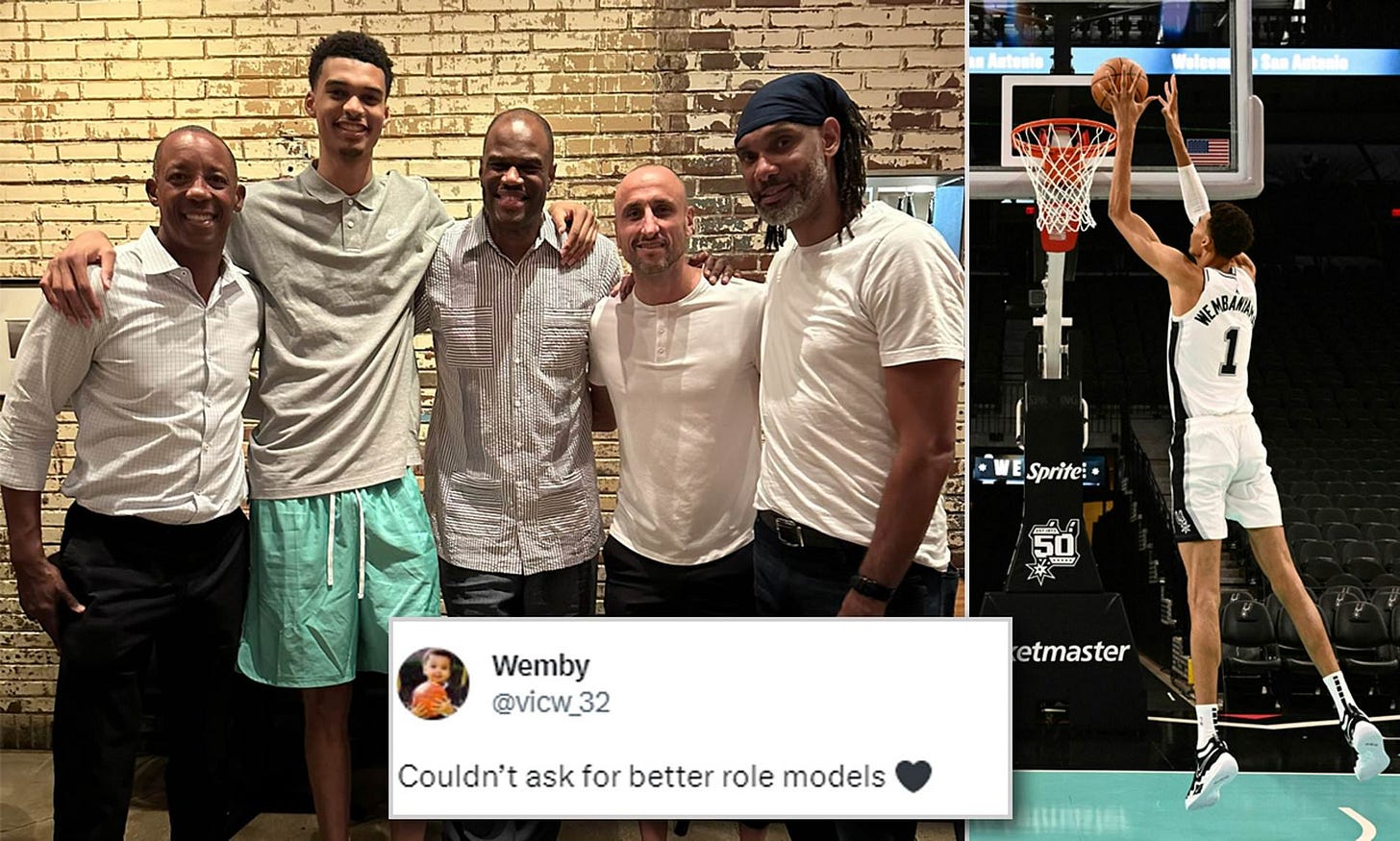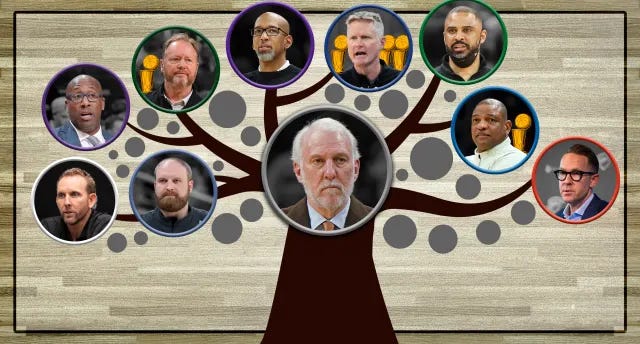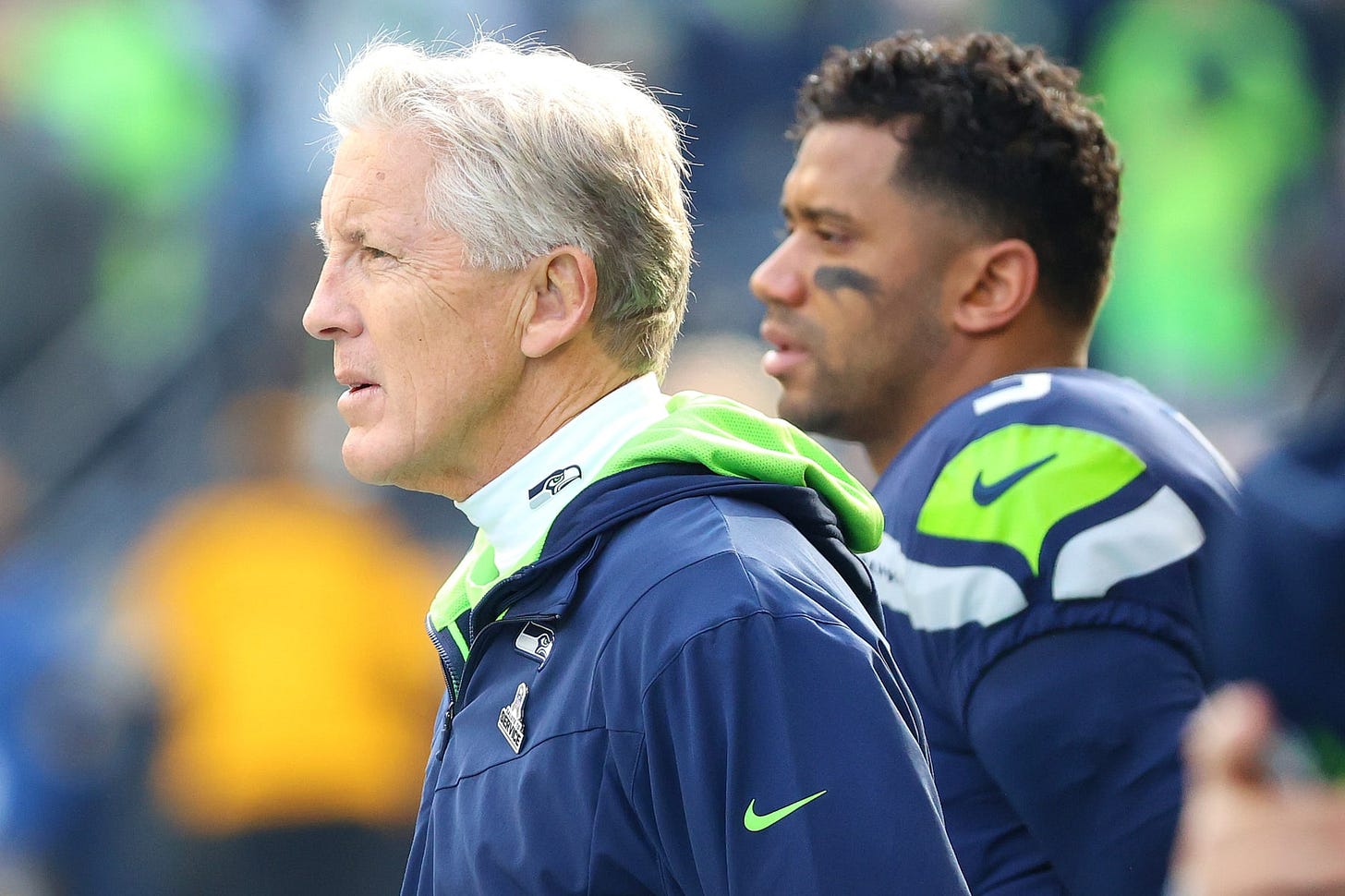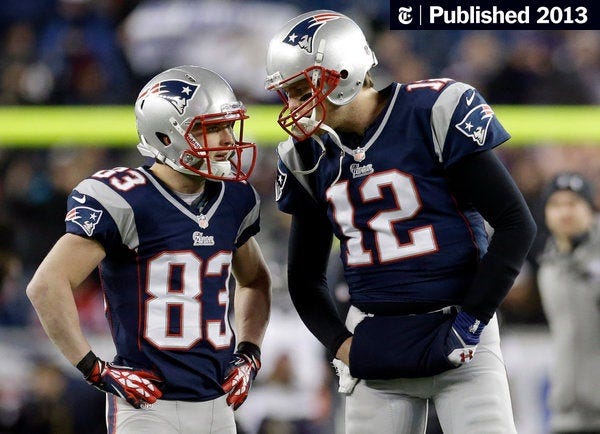📚 Upside Analysis: Leadership Skills Development - 4 Case Studies: The San Antonio Spurs (NBA), The Tampa Bay Lightning (NHL), The Seattle Seahawks (NFL), The New England Patriots (NFL)
Case Study #1: The San Antonio Spurs: A Culture Built on Stability and Intentional Mentorship
In elite sports, sustained excellence often hinges not only on talent and tactics but on culture, leadership, and mentorship systems. Few organizations exemplify this better than the San Antonio Spurs, a franchise widely regarded as a model of long-term success and internal leadership development.
At the heart of the Spurs’ system is a stable and value-driven culture, spearheaded by long-time head coach Gregg Popovich, who has been instrumental in creating an environment where mentorship is not incidental but strategically embedded into the system.
Popovich’s leadership style combines high expectations with deep relational investment. He’s known for his tactical brilliance, but what truly sets him apart is his emphasis on character, communication, and connection. These elements have created fertile ground for player-led mentorship, where veterans guide younger players in both performance and professionalism.
Veteran Leadership as a Development Engine
The Spurs’ dynasty years featured stars like Tim Duncan, Manu Ginóbili, and Tony Parker—not only exceptional athletes but selfless leaders who understood their roles as stewards of the team culture. As they matured, they intentionally passed on Spurs values to the next generation of players, often mentoring international rookies or late draft picks unfamiliar with NBA demands.
This model wasn’t built on charisma or hierarchy but on shared responsibility and daily consistency. Duncan, famously quiet, led by example, setting a tone of humility and team-first behavior. Ginóbili and Parker, both fiery and passionate, added layers of diversity to the mentorship framework—each player brought their own flavor, but the common denominator was buy-in to the Spurs ethos.
Strategic International Integration
Another pillar of the Spurs' leadership development model is their global scouting strategy, which brought in talent from outside traditional U.S. pipelines. Players like Tiago Splitter, Boris Diaw, and Patty Mills not only adapted but became leaders themselves under the Spurs system. By building a multicultural roster, the organization fostered cross-cultural mentorship, where communication, adaptability, and empathy were critical to cohesion.
Picture: Boris Diaw (Left), Lebron James (Right)
The G-League and Front Office as Leadership Pipelines
Leadership development within the Spurs doesn’t stop at the players. The Spurs have one of the most integrated developmental ecosystems in pro sports, including their G-League affiliate, the Austin Spurs. This system serves as both a talent and leadership incubator, allowing emerging coaches and players to grow within the Spurs’ culture before joining the NBA roster.
The front office reflects the same philosophy. Former Spurs players and staff have gone on to become head coaches and executives across the league—Mike Budenholzer, Ime Udoka, Becky Hammon, James Borrego, and Sam Presti, to name a few. This diaspora underscores how the Spurs prioritize teaching, mentorship, and strategic succession planning across the organization.
Picture: Becky Hammon (Left), Gregg Popovich (Right)
Mentorship as a Competitive Advantage
The impact of the Spurs’ mentorship model on performance is both measurable and cultural. On the court, it contributed to two decades of near-unparalleled consistency: five NBA championships, 22 consecutive playoff appearances (1998–2019), and one of the highest winning percentages in professional sports.
But perhaps more impressively, the team thrived despite roster changes, injuries, and evolving playing styles across eras. This consistency wasn’t just about X’s and O’s—it was the product of a deeply embedded system where every new player entered a framework of trust, accountability, and clarity of role, often expedited by guidance from veteran mentors. Rookies and role players developed faster, stars shared the ball, and egos rarely fractured chemistry. The Spurs didn’t just build teams—they built leadership ecosystems, and that foundation became their competitive edge.
Lessons for Leadership in Elite Sports
The Spurs system shows that leadership development in elite sports is not a program—it’s a philosophy baked into daily operations. The key elements of their success include:
Intentional mentorship roles for veterans and coaches
Culture-first recruiting and development
Cross-cultural team building and empathy training
Long-term leadership pipelines from players to front office
Consistency in vision and communication
As sports organizations across the globe face challenges of roster turnover, coaching instability, and the pressures of performance, the Spurs offer a proven blueprint: Build leaders, not just athletes. Develop mentors, not just managers. And above all, make leadership a shared, evolving responsibility embedded in your culture—not just your job titles.
Case Study #2: The Tampa Bay Lightning Blueprint: Building Leaders from the Inside Out
In the world of elite sports, dynasties aren’t built on talent alone—they’re built on culture, consistency, and leadership. The Tampa Bay Lightning have become a gold standard for how to sustain success in the NHL, not just through drafting and development, but by systematically grooming leaders at every level of the organization.
With a roster that has achieved two Stanley Cups (2020, 2021), multiple deep playoff runs, and maintained a playoff-caliber team even under cap constraints and roster turnover, the Lightning have done something few franchises manage: They’ve built a system that doesn’t just produce players—it produces leaders.
The Leadership Core: Foundation of the Franchise
The Lightning’s identity over the last decade has been shaped by a core group of emotionally intelligent, team-first veterans—none more central than Captain Steven Stamkos and defensive anchor Victor Hedman. These two are more than just elite athletes—they’re cultural custodians. They define the tone of the locker room and hold teammates to the standards that have propelled Tampa to the top of the league.
What’s important is how they lead: not by dominance or speeches, but through approachability, accountability, and day-to-day example. Stamkos, in particular, has been praised for evolving as a communicator—learning how to empower younger teammates and foster cohesion across a diverse locker room.
And this leadership isn’t confined to the official “C” and “A” on jerseys. Over time, other veterans like Ryan McDonagh, Alex Killorn, Ondřej Palát, and now Brayden Point, Anthony Cirelli, and Erik Černák have stepped into influential leadership roles. In Tampa, leadership is shared, not siloed, which has allowed the team to sustain a high-performance culture even as key personnel have come and gone.
Picture: Alex Killorn, Ryan McDonagh
From Syracuse to Stanley Cup: Leadership Starts in the AHL
Where the Lightning truly stand apart is in how early and consistently they begin developing leadership capacity. Within their AHL affiliate, the Syracuse Crunch, players are immersed in the same cultural values that define the NHL team. There’s a deliberate emphasis on professional habits, team-first mentality, communication skills, and character under pressure.
Prospects are not just asked to perform—they’re taught how to take ownership of their environment. Young players often take on mentorship roles for newer teammates, lead community initiatives, or take responsibility in the locker room. These aren't throwaway experiences—they’re deliberate reps in leadership training.
By the time a player is called up to Tampa, they’re not just technically ready—they’re culturally ready. They understand how the Lightning operate, how leaders behave, and what’s expected of them beyond the score sheet.
Players like Ross Colton, Mathieu Joseph, and Taylor Raddysh rose through that system and arrived in Tampa with more than skill—they arrived with institutional alignment. That alignment—between player development and leadership development—has given Tampa unmatched continuity across seasons.
A Culture of Shared Accountability
Leadership in Tampa is not about ego. It’s about shared accountability. The team is known for its clear internal expectations, honest communication, and a mutual trust between players and staff. That trust is reinforced by consistent messaging from the top—GM Julien BriseBois, building on the foundation set by Steve Yzerman, and a coaching staff led by Jon Cooper, the longest-tenured coach in the NHL.
Cooper is especially key in this equation. His communication style—direct, but personable—has fostered an environment where player input is welcomed and constructive dialogue is expected. He’s not just coaching games; he’s developing people. Under his leadership, even players who don’t wear letters are encouraged to speak up and lead from wherever they stand.
This is how players grow into leadership roles organically. It’s not about waiting your turn—it’s about earning trust through your consistency, your attitude, and your example.
Sustaining Success Through Cultural Continuity
What makes the Lightning’s leadership model so effective is its resilience across transitions. Even as roster turnover has stripped away familiar faces year after year due to cap constraints, the team has not lost its identity. Why? Because that identity doesn’t live in individual players—it lives in the culture. And the culture is taught, reinforced, and lived from the AHL up through the NHL.
Newcomers—whether through trades or free agency—don’t have to guess what’s expected of them. They’re brought into a clear, player-driven culture, with strong peer mentors and coaches who are aligned on values. That’s why players like Pat Maroon, Zach Bogosian, or Nick Paul have integrated so seamlessly and contributed immediately—not just on the ice, but in the room.
The Takeaway: Build Leaders, Not Just Rosters
The Lightning remind us that championship organizations don’t rely on talent alone. They build ecosystems of leadership, where culture is cultivated, leadership is shared, and every player—whether in Syracuse or the Stanley Cup Final—knows they are part of something bigger than themselves.
For GMs, coaches, and performance leaders across sports, the Lightning offer a masterclass in how to develop talent and character. Start early. Teach consistently. Reward leadership as much as performance. And make sure your culture is strong enough to outlast any one player.
In elite sport, that’s how dynasties are built.
Case Study #3: Leadership Development and the Seattle Seahawks: Inside the Player Council Model
In the landscape of elite sports, the difference between a good team and a great one often comes down to culture and communication. Under head coach Pete Carroll, the Seattle Seahawks developed a distinctive approach to leadership: the formation and empowerment of a Player Leadership Council, designed to make players co-authors of the team’s identity and direction.
Empowering Players Through Voice and Accountability
At the heart of the Seahawks' model is the belief that great leadership can’t be imposed—it must be invited and developed from within. The Player Council was created to serve as a bridge between the coaching staff and the locker room, giving athletes not only a seat at the table, but a real stake in shaping team norms, accountability structures, and even daily operations.
Composed of veteran leaders and rising voices across different position groups, the council’s role extended beyond game-day leadership. They met regularly with Carroll and his staff to discuss team morale, internal dynamics, communication gaps, and strategic messaging. This wasn't window dressing; players’ input often informed how the coaching staff approached conflict resolution, performance issues, and even practice structure.
Creating Buy-In Through Ownership
The council became a mechanism for distributed leadership, where accountability wasn’t top-down—it was lateral and communal. When emerging stars like Russell Wilson, Bobby Wagner, or Doug Baldwin stepped into leadership roles, it wasn’t by accident—it was through a system that deliberately cultivated voice, presence, and emotional intelligence.
Picture: Pete Carroll (Left), Russell Wilson (Right)
This sense of player ownership enhanced internal trust and reduced friction between coaching and locker room cultures, even during high-stakes playoff runs. It also helped navigate periods of adversity, like the departures of core players from the original "Legion of Boom" era. In those moments, leadership didn’t collapse—it evolved, guided by council members who already understood the cultural DNA.
Development Beyond the Field
What sets the Seahawks apart is that their leadership system wasn’t limited to on-field impact—it was explicitly tied to personal development and life skills. Carroll, alongside team psychologist Dr. Michael Gervais, fostered an environment of self-awareness and purpose-driven performance. The leadership council became a conduit for deeper conversations about identity, mental wellness, social justice, and long-term vision beyond football.
Picture: Pete Carroll and team psychologist Dr. Michael Gervais.
This ecosystem allowed players to lead with more than intensity—they led with intentionality and emotional fluency. It also prepared many for success beyond their playing careers, as former Seahawks have transitioned into roles in media, entrepreneurship, philanthropy, and coaching, carrying with them the same principles learned within the team.
Impact on Performance and Longevity
During the height of the Seahawks’ run in the 2010s—including back-to-back Super Bowl appearances (XLVIII and XLIX) and consistent playoff contention—the leadership council provided the glue for one of the most competitive and unified locker rooms in the NFL. The team’s mental toughness, comeback resilience, and locker room cohesion weren’t just byproducts of talent—they were a direct result of a deliberate leadership framework.
Even as the roster turned over, the presence of a leadership council enabled continuity in values and behaviors. Younger players entered a culture where leadership wasn’t abstract—it was visible, inclusive, and taught.
The Takeaway: Designing Leadership Systems for Elite Performance
The Seahawks’ leadership council demonstrates how elite sports teams can engineer leadership from the inside out, rather than relying solely on captains or coaching authority. By institutionalizing peer mentorship, cross-positional dialogue, and emotional intelligence development, the Seahawks created a model where every player has the potential to lead, grow, and contribute to the team's identity.
In a league where performance windows are short and locker room dynamics can be volatile, this approach gave Seattle not only a competitive edge—but a cultural legacy.
Case Study #4: The New England Patriots: A Masterclass in Leadership Skills Development
When you hear "New England Patriots," you probably think of dynasties, Super Bowl trophies, and unparalleled NFL success. But underneath the surface of their six championships and countless division titles lies something even more powerful — a deliberate, highly disciplined culture of leadership skills development.
Since Bill Belichick took over as head coach in 2000, the Patriots have built more than just great teams — they've built leaders. From rookies to veterans, from practice squad players to Hall of Famers, leadership has been baked into every fiber of the organization.
In a world obsessed with short-term success, the Patriots offer a long-term blueprint for sustainable excellence — one rooted in developing leaders at every level.
"Do Your Job" — Accountability as the First Building Block
"Do Your Job" became the unofficial slogan of the Patriots during their reign of dominance. At first glance, it seems basic — but it’s a profound cultural cornerstone.
This mantra meant more than just doing what’s asked. It meant mastering your craft, anticipating challenges, executing under pressure, and understanding how your role connects to the larger mission. Every player knew that if he failed to do his job, it could jeopardize the work of ten others. The emphasis on personal accountability was relentless — and contagious.
Players who internalized this mindset didn’t just become reliable teammates; they became natural leaders, setting the tone for others through discipline and consistency.
Leadership Lesson: Great leadership starts with mastering your own responsibilities and modeling accountability.
Picture: Tom Brady (Left), Bill Belichick (Right)
Developing Leaders at All Levels — Not Just Captains
One of the Patriots’ most underrated achievements is how they systematically developed leaders — regardless of position or seniority.
While players like Tom Brady and Devin McCourty were expected to lead, Belichick also cultivated leadership in role players and backups. Everyone from special teams aces like Matthew Slater to mid-round draft picks like David Andrews (now a captain) was expected to think, prepare, and communicate like a leader.
Young players were encouraged to lead drills, study film like coaches, and speak up during team meetings. Leadership wasn’t about titles — it was about actions.
By investing in leadership at every level, the Patriots created a culture where leadership was abundant, not scarce.
Leadership Lesson: Don't wait for seniority to train leaders — develop leadership muscles in everyone early and often.
Picture: Robert Kraft (Left), Matthew Slater (Right)
Adaptability as a Core Leadership Trait
Every year in the NFL is different: injuries, roster changes, new schemes, new threats. No team embraced this reality better than the Patriots.
One season, Tom Brady might throw for 5,000 yards. Another season, they might dominate with a power running game and suffocating defense. Belichick famously customized game plans week-to-week, and sometimes drive-to-drive.
This demanded incredible flexibility from players and leaders alike. Linebackers had to cover tight ends one week and blitz the quarterback the next. Wide receivers sometimes lined up at running back. Versatility wasn’t just a skill — it was a leadership expectation.
Leadership, in the Patriots' world, meant staying poised amid change and helping teammates adjust on the fly.
Leadership Lesson: The best leaders don’t just survive change — they guide others through it.
Silent Leadership — Leading Without Needing the Spotlight
In today’s world of constant social media and self-promotion, the Patriots took a refreshingly different approach. Many of their greatest leaders weren’t flashy or vocal.
Players like James White — quiet, composed, and devastatingly effective — became cultural pillars. They led through their preparation, their demeanor, and their ability to perform consistently in the biggest moments (just ask the Falcons about Super Bowl LI).
The Patriots proved that leadership isn’t always loud. Sometimes, the best leaders are the ones who lead simply by how they work, how they handle adversity, and how they treat others.
Leadership Lesson: Authentic, quiet leadership is just as powerful — sometimes more powerful — than public leadership.
Picture: James White (Left), Bill Belichick (Right)
Culture Over Talent — Protecting the Leadership Ecosystem
Perhaps the most controversial aspect of the Patriots’ leadership model was their ruthless protection of team culture.
Time and again, they let go of talented players who didn’t buy into the culture — no matter how skilled. Even beloved stars like Lawyer Milloy, Wes Welker, and Richard Seymour were moved on from when the organization believed it was necessary for the greater good.
Why? Because one selfish mindset can undermine a whole locker room. One leader who prioritizes themselves over the team erodes trust instantly. The Patriots understood that talent is common in the NFL — but culture and character are rare and must be defended at all costs.
Leadership Lesson: No matter how talented someone is, if they can’t align with the culture, they can’t be part of the long-term plan.
Picture: Wes Welker (Left), Tom Brady (Right)
Final Reflections: The Enduring Lessons from New England
The New England Patriots' dynasty wasn’t powered simply by all-time greats like Tom Brady. It was powered by a deeper, systemic commitment to growing leaders who could be counted on in any situation — from overtime in the Super Bowl to a rainy Wednesday practice in November.
In a high-pressure, high-visibility environment like the NFL, many organizations chase quick fixes or put all their faith in a few star personalities. The Patriots built something much harder — and much more enduring.
For leaders in sports, business, education, or any other field, the Patriots' model offers timeless lessons:
Master yourself before trying to lead others.
Make leadership a universal expectation, not a rare title.
View change as an opportunity to lead.
Encourage authentic leadership styles.
Guard your culture like your future depends on it — because it does.
Ultimately, the Patriots remind us that trophies gather dust, but leadership — real leadership — leaves a legacy.
You may also like:
🧠 Upside Analysis: Leadership Development in Elite Sports: Key Trends, Drivers, Challenges, Methods, Recommendations to Teams
Leadership in elite sports is a defining factor in a team's success, influencing performance, team cohesion, and long-term sustainability. In modern sports, leadership extends beyond the coaching staff to players, executives, and support staff who play vital roles in fostering a high-performance culture. Successful teams recognize that leadership develo…

















